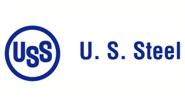Steel Mills

US Steel Gary Works Operating One Blast Furnace
Written by John Packard
April 8, 2014
US Steel has been very cooperative answering Steel Market Update inquiries regarding the status of their Gary Works and Great Lakes steel mills. Both mills have issues regarding steelmaking operations. Because the steel industry is prone to over-react when production issues hit any mill we thought it prudent to try to understand to the best of our knowledge what the issues are and how will they impact the overall steel market. The information SMU is about to share with our readers is from U.S. Steel and not the rumor mill.
Gary Works, which is the largest production facility for US Steel, normally operates four blast furnaces. The largest blast furnace is #14 which, according to AIST data, is capable of producing 9,200 tons per day of pig iron. The other three furnaces (#4, #6, #8) are rated at approximately 3,000 to 4,500 tons of pig iron per day (combined about 11,300 tons based on AIST 2009 data – the tons could be higher with improvements made since then). Again, data shown is for pig iron. To get steel production, you will need to add approximately 25 percent scrap charge, so actual steel production numbers are higher than the pig iron production referenced.
US Steel advised Steel Market Update this afternoon that they received one iron ore vessel on Sunday and two vessels from Duluth, Minnesota today and have another vessel “right behind the two from Duluth.”
The mill advised SMU later in the day (late this afternoon) that one blast furnace was running at Gary at a reduced rate but that situation is changing with the arrival of iron ore vessels.
Steel buyers need to be aware that Gary Works is producing material and the expectation is the mill will continue to ramp up production on the one furnace running and then add other furnaces as ore becomes available.
According to the USS spokesperson, “Great Lakes iron and steelmaking remains offline. We continue to analyze the repairs needed and remain in contact with our customers regarding the situation.”
Great Lakes, according to AIST data, has three blast furnaces although at any one time only two furnaces are running. Each furnace is capable of producing 3700 to 4100 tons of pig iron which then goes to the BOP (basic oxygen process or furnace) where scrap is added to make steel. Both the blast furnaces and their BOP’s (2 vessels) are currently “offline” according to the company.
Late last week an independent contractor working on repairs to the roof above the BOP’s was fatally injured when the crane tipped over.
Steel Market Update will continue to follow these developments very closely and will advise our readers as conditions change.

John Packard
Read more from John PackardLatest in Steel Mills

Nucor names Batterbee, Bledsoe to HR roles
Nucor Corp. has promoted Thomas J. Batterbee to the position EVP of human resources and talent and appointed Elizabeth Bledsoe to the newly created position of president of human resources and talent.

Millett sees tariffs, CORE case benefiting SDI
Steel Dynamics' top exec thinks Trump’s tariff policies, as well as the results from the recent CORE case, will prove advantageous to the Fort Wayne, Ind.-based steelmaker and aluminum company.

USW digs in on opposition to USS-Nippon deal
“We remain deeply concerned about the national and economic security implications of the subject transaction,” the union stated in the letter dated April 21.

SDI’s Q1 earnings slump on-year, but up sequentially
SDI earnings slip in first quarter year over year, but are up sequentially.

POSCO inks MoU with Hyundai on Louisiana EAF mill
POSCO has signed a Memorandum of Understanding (MoU) with Hyundai Motor Group that includes an equity investment in Hyundai’s previously announced EAF mill set to be built in Louisiana.
